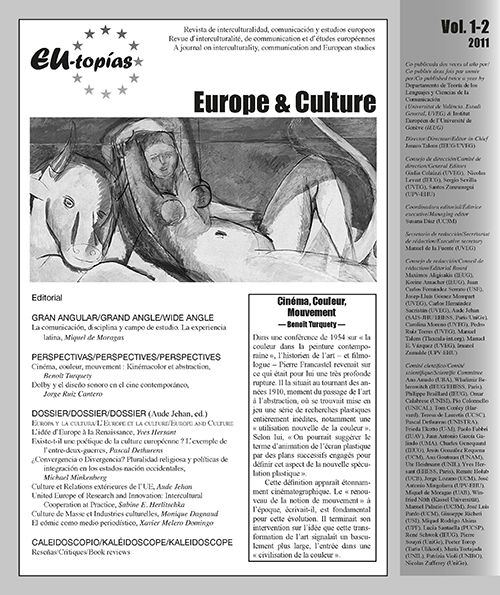Europe unie de la recherche et de l'innovation. Coopération interculturelle en pratique
DOI :
https://doi.org/10.7203/eutopias.1.18444Mots-clés :
Science et technologie, innovation, compétitivité, cooperation inter- culturelle, espace européen de recherche (EER), stratégie de lisbonne, stratégie europe 2020, programmes cadre Résumé
Résumé
Avec ses programmes-cadres de recherche, de développement techno- logique et de démonstration, l’Union européenne a mis en place – dès 1984 – ce qui est devenu les plus importants programmes de recherche du monde entier, en termes de coopération ainsi que de compétitivité. Ayant pour objectif de renforcer la compétitivité européenne, les programmes-cadres ont évolué en tant qu’instrument phare visant au développement d’un Espace de recherche européen, un marché européen unique au monde de la science et la technologie – garantissant un «mar- ché» ouvert et transparent de compétences, d’ idées et de savoir-faire, de même que la création d’une Europe de la recherche et de l’innovation unie. Ayant rassemblé par des projets de financement près de 400.000 équipes de chercheurs d’Europe et du monde entier, dont certaines d’entres elles à plusieurs reprises, l’impact des programmes-cadres va bien au delà du simple un financement de projets. En effet, ils ont pour principaux atouts de développer une culture de coopération entre les meilleures universités, entreprises, organismes de recherche en Europe et au-delà. Ils réunissent ainsi différents acteurs, secteurs, cultures, sexes, nationalités, etc.
Au cours des 25 dernières années, l’Europe a su développer et profes- sionnaliser cette capacité de coopération interculturelle, qui représen- te aujourd’hui un atout concurrentiel majeur et un avantage pour les membres de la communauté de la recherche européenne: contribuer à résoudre les défis mondiaux par coopération international, donc inter- culturelle, des meilleurs «cerveaux » en science, technologie et innovation.
 Téléchargements
Téléchargements
 Références
Références
AHO, E., CORNU, J., GEORGHIOU, L., and A. SUBIRÁ (2006). ‘Creating an Innovative Europe’, Report of the Independent Expert Group on R&D and Innovation appointed following the Hampton Court Summit’, January 2006. Luxembourg: Office for Official Publications of the European Communities.
ERAWATCH (2008). ‘Activities of EU member states with regard to the reform of the public research base’; Available at: http://cordis.europa.eu/erawatch/index.cfm?fuseaction=home.downloadFile&fileID=1133
ERAWATCH analytical country reports (2009). Available at: http://cordis.europa.eu/erawatch/index.cfm?fuseaction=reports.content&topicID=600&parent ID=592
ESFRI (2009). ‘European Roadmap for Research Infrastructures Implementation Report 2009’; Available at: http://ec.europa.eu/research/infrastructures/pdf/esfri/home/implementation_report_2009_en.pdf
Europe’s top research universities in FP6: scope and drivers of participation, Luisa Henriques, Antoine Schoen, Dimitrios Pontikakis, JRC Technical Notes, EUR 24006 EN – 2009.
Towards Joint Programming in Research: Working together to tackle common challenges more effectively, European Commission, COM (2008) 468 final.
European Commission (2006b). ‘Delivering on the modernisation agenda for universities: education, research and innovation’, Communication from the Commission, COM(2006) 208, Brussels, 10 May.
European Commission (2006c). ‘Putting knowledge into practice: A broad-based innovation strategy for the EU’, Brussels, Communication from the Commission, COM(2006) 502 final, Brussels, 13 September.
European Commission (2007a). Commission Staff Working Paper, Accompanying document to the Report from the Commission to the Council on the Council Resolution of 23 November 2007 on ‘Modernising Universities for Europe’s competitiveness in a global knowledge economy’, COM(2008) 680 final. Available at: http://ec.europa.eu/education/higher-education/doc/com/sec2719_en.pdf
European Commission (2008). ‘A Strategic European Framework for International Science and Technology Cooperation’, European Commission, COM (2008) 588 final.
European Commission (2008f). ‘Commission recommendation on the management of intellectual property in knowledge transfer activities and Code of Practice for universities and other public research organisations’, Communication from the Commission, COM(2008)1329, April 10. Available at: http://ec.europa.eu/invest-in-research/pdf/ip_recommendation_en.pdf
European Commission (2009i). ‘A new partnership for the modernisation of universities: the EU Forum for University Business Dialogue’, Communication from the Commission, COM(2009) 158, April 2 2009. Available at: http://ec.europa.eu/education/higher-education/doc/business/com158_en.pdf
European Commission (2009j). ‘Reviewing Community innovation policy in a changing world’, Communication from the Commission, COM(2009) 442, 2 September 2009. Available at: http://ec.europa.eu/enterprise/policies/innovation/files/com(2009)442final_en.pdf
European Commission (2010b). ‘New Skills for New Jobs: Action Now’, Report of an Expert Group. Available at: http://ec.europa.eu/social/main.jsp?catId=568&langId=en
European Commission (2010c). ‘Simplifying the Implementation of the Research Framework Programmes’, Communication from the Commission, COM(2010)187, Brussels, 29 April 2010. Available at: http://ec.europa.eu/research/fp7/pdf/communication_on_simplification_2010_en.pdf
European Commission (2010d). ‘Unlocking the potential of cultural and creative industries’, Green Paper, COM(2010)183, Brussels. Available at: http://ec.europa.eu/culture/our-policy-development/doc/GreenPaper_creative_industries_en.pdf
European Commission (2010g). ‘Special Eurobarometer Survey No. 340 on Science and Technology’, June 2010; Available at: http://ec.europa.eu/public_opinion/archives/ebs/ebs_340_en.pdf
European Commission (2010h). ‘Eurobarometer survey No. 73’, Spring 2010; Available at: http://ec.europa.eu/public_opinion/archives/eb/eb73/eb73_first_en.pdf
FERNÁNDEZ-ZUBIETA , A. and GUY, K. (2010). ‘Developing the European Research Area: Improving Knowledge Flows via Researcher Mobility’, JRC Scientific and Technical Report, JRC-IPTS. Forthcoming.
FERRARI, A., CACHIA, R. and PUNIE , Y. (2009). ‘Innovation and Creativity in Education and Training in the EU Member States: Fostering Creative Learning and Supporting Innovative Teaching: Literature review on Innovation and Creativity in E&T in the EU Member States (ICEAC)’, JRC Technical Note 52374, JRCIPTS. Available at: http://is.jrc.ec.europa/pages/EAP/iceac.html
Preparing Europe for a new Renaissance, A Strategic View of the European Research Area, First Report of the European Research Area Board, October 2009.
Realising the New Renaissance, Policy proposals for developing a world-class research and innovation space in Europe 2030, Second Report of the European Research Area Board — 2010.
Téléchargements
Publiée
Comment citer
-
Résumé249
-
PDF 66
Numéro
Rubrique
Licence
![]()
Tous les contenus publiés dans EU-topías. Revista de Interculturalidad, Comunicación y Estudios Europeos est sous licence Creative Commons Paternité-Pas d'Utilisation Commerciale-Partage des Conditions Initiales à l'Identique 4.0. Le texte complet de la licence peut être trouvé à http://creativecommons.org/licenses/by-nc-sa/4.0
Ils peuvent être copiés, utilisés, diffusés, transmis et affichés publiquement, à condition que:
- L'auteur et la source originale de la publication sont cités (magazine, éditeur et URL de l'œuvre).
- Ils ne sont pas utilisés à des fins commerciales.
- L'existence et les spécifications de cette licence d'utilisation sont mentionnées



